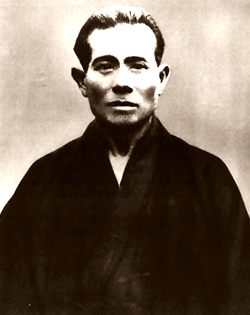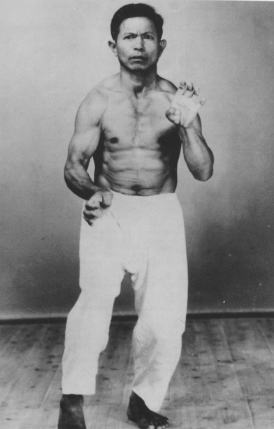Grandmaster Kanbun Uechi

The founder of Uechi-Ryu Karate was an Okinawan named Kanbun Uechi. He was born in 1877 to a family of samurai status, but since the occupation of Okinawa in the 1600’s by the powerful Satsuma clan from the island of Kyushu on mainland Japan, this status was taken away. The Uechi family turned to farming to make a living on the northern side of the island.
As Kanbun grew, so did his interest in the martial arts. It is said that he became quite good with the bo (6 foot staff). When he turned 18 and became old enough to be drafted into the Japanese army (1897), he and his parents decided that the best course of action would be for him to leave Okinawa for China. At the time, many Okinawans felt oppressed by the Japanese invaders and did not feel it was right that they should be forced to fight for what they felt was another country. As a result, many young men left for China where there was a strong historical tie between the two peoples. So, in 1897, Kanbun left Okinawa for Fuzhou city in southern China (Fukien Province).
After a short adjustment period, Kanbun began to study Chinese Kenpo (Paingainoon) under the famous Chinese master Zhou Zi He (“Shu Shi Wa” in Japanese). He studied under Zhou Zi He for ten years, becoming fluent in the Chinese language and proficient in Chinese medicine. After receiving a teacher’s certificate in 1904, Kanbun became one of the first non-Chinese to teach Pangainoon in China when he opened his own school in the province of Nansoue.
He had been warned by the villagers that it was unwise to open a school there as several people had already tried and failed. In time, however, Kanbun Uechis reputation grew to the point that he was able to develop a very successful school. Then, one of his students, who was quiet and unassuming by nature, got into a fight with someone over a border dispute and killed him in self-defense. Unfortunately, the people of the village blamed Kanbun for teaching the student, which forced him to leave China after thirteen years.
Kanbun returned to Okinawa in 1910 at the age of 33, and vowed never to teach karate again. He became a farmer, married Gozei Toyama, and eventually had four children (two boys and two girls): Kanei (1911), Tsuru, Kame, and Kansei. After two uneventful years, an old student of his from China came to Okinawa and tried to convince Kanbun to teach again but with no success. When Kanbun’s old student got into a fight with one of the area’s karate masters and defeated him, people asked from whom he learned his karate. He told them that Kanbun Uechi was the real teacher and people should seek him out. Kanbun Uechi’s reputation in Okinawa grew, even though no one had seen him do anything. When people asked him to teach them, he denied any knowledge of the martial arts. When the townspeople finally confronted Kanbun with his old student, he could no longer deny it, but still he refused to teach.
Every year the local police department held a large martial arts demonstration where the local karate masters displayed their talent. The other karate masters, who were anxious to see Kanbun perform, asked the mayor of the city to ask that Kanbun participate. Uechi did not feel it would be proper to refuse a request from the mayor and when forced to perform in front of all of his peers, he performed an awe-inspiring “Seisan” kata, which was said to be his favorite.
Due to the great skill of his demonstration, nobody wanted to perform after Kanbun Uechi, and the festival ended. Kanbun Uechi’s reputation grew so much after that, that he was asked by Itosu Anko, a great karate expert in Shorin-Ryu, to teach karate at the teachers college in Okinawa. There was so much pressure, that the quiet and modest Kanbun Uechi left for Wakayama, Japan.
Kanbun found a job at a spinning mill and lived beside it in a housing development for fellow Okinawans. There he met a young Okinawan named Ryuyu Tomoyose, who for some reason suspected that Kanbun knew karate. Tomoyose would make up stories concerning make-believe fights and tell them to Uechi, who would then tell Tomoyose what he should have done during the fight. Tomoyose tried to convince Kanbun to resume teaching, but he continued to refuse.
Finally, after two years, Kanbun agreed to teach again. Tomoyose recruited other Okinawans around the mill and soon Kanbun Uechi had a flourishing school of several hundred students. His most important student was his oldest son Kanei, who trained for ten years before returning to Okinawa to open his own school in Nago.
In 1949, Kanbun’s students renamed the style Uechi-Ryu in the Master’s honor.
Kanbun taught in Wakayama until 1946 when he returned to Okinawa. He handed over his school (Pangainoon-ryu Karate-jutsu Kenkyu-jo) to Ryuyu Tomoyose, and re-opened Kanei’s school in Nago which had been closed during the war. Kanbun taught for two more years until he fell ill with a liver problem at the age of seventy-one. However, because a fortune-teller had once told him that he would live until his eighties, he refused to see a doctor, and died on November 25, 1948, on the island of Ie-Jima off the coast of Okinawa.
It is rumored that on the day that Kanbun Uechi died, his pain was so intense that he jumped out of bed and got into a sanchin stance because it was the only position where he felt no pain, and then died.
Kanbun’s son, Kanei Uechi moved to Ginowan City a year later and opened a school that his students had built for him. In 1956, he moved his school and family (three boys and three girls) to Futenma, which is still the headquarters of the Uechi-Ryu Karate Association. Kanei continued to teach in Okinawa, and in the 1950s was one of the first Okinawans to open karate classes to foreigners.
During the 1960s, Uechi-Ryu Karate-do grew tremendously around the world due to the efforts of Kanei Uechi, who was awarded judan (tenth degree) in 1967 by both the Zen Nihon Karate-do Renmei (All Japan Karate Federation) and the Zen Okinawa Karate-do Renmei (All Okinawa Karate Federation). It was during the 1950s and 60s that many of the supplemental exercises were added to the style: the warm up exercises, “hojo undo”, the technical drills, five intermediate katas, and the kumite sparring drills.
Kanei Uechi was very much like his father, humble and unassuming. He was respected by his students as well as his peers in the martial arts. He showed interest in all his students including his American “children.” Kanei made two separate trips to the United States, once in 1967 and the other in 1984 to check on the progress of Uechi-Ryu karate in America.
Kanei continued to lead the Uechi world until his death on February 24, 1991. He was 80 years old. Since then, the Uechi-Ryu karate system has split up into several different organizations.
